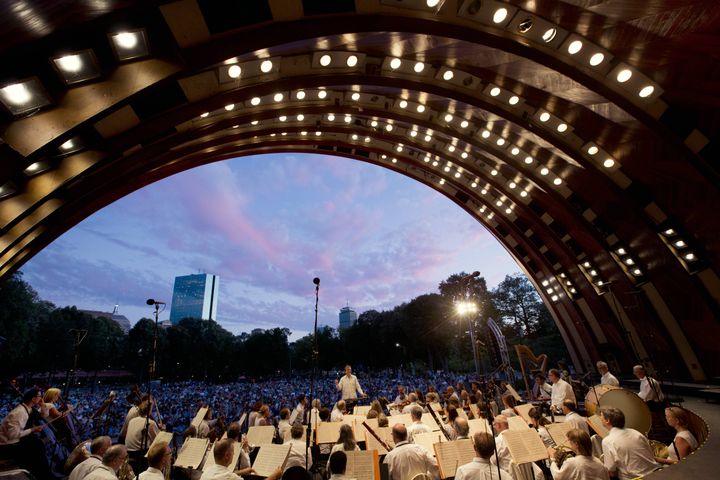
Looking out over the audience.
“Boston Landmarks Orchestra is dedicated to three things,” said Christopher Wilkins, the group’s music director. “Great orchestral music, access for all, and inclusion.”
The Boston Landmarks Orchestra is a community-based arts organization that brings together residents from different parts of the city, including underserved communities, for outdoor classical music concerts that are free to the public.
Its 2017 season opens July 19 at the DCR’s Hatch Shell along the Charles River Esplanade in Boston’s Back Bay.
The ensemble will perform with Back Bay Chorale, Zumix, Conservatory Lab Charter School, Camp Harbor View, Boys & Girls Clubs, and dance ensembles from throughout the city, among many others.
Their concert series reconfirms Arthur Fiedler's legacy, whose goal was to make orchestral music more popular and accessible to the general public. The series of free concerts he established on the Esplanade is commemorated in Ralph Helmick's giant bust of Fiedler located near the Hatch Shell. The Boston Landmarks Orchestra continues that tradition in what they describe as "a gift to the City of Boston."
For Wilkins, the perfect concert creates a shared experience for people of many backgrounds.
“A spirit of joy and openness lies at the heart of all our programs,” he said. “Families, children, newcomers, and first-time concertgoers all have a welcome place at our concerts. The 2017 season celebrates the scenic beauty of our city, the brilliance of our orchestra, and the diverse talents of our many collaborators.”
Collaboration is key to realizing the group’s ambitious repertoire. Each season, the orchestra collaborates widely with other musicians, artists, and community members; some are veteran collaborators while others have never been on stage before.
“You can make an event technically accessible,” Wilkins says, “but that doesn’t mean people will choose to come and be involved. So we program in a way to invite people to participate.”
To encourage audience participation, Wilkins created the “Maestro Zone” next to the Hatch Shell’s main stage, “where young people and the young at heart can follow the lead of the orchestra’s associate conductor in conducting the orchestra.”
The late Charles Ansbacher, a conductor and community advocate, founded Boston Landmarks Orchestra in 2001. Ansbacher wanted his orchestra to perform in different neighborhoods across the city. The group took its name from its first concert locations: local landmarks of historical significance, including Paul Revere House, Charlestown Navy Yard, and Jamaica Pond.
Wilkins says of Ansbacher, “He believed in the power of public art and dedicated a much of his life to that goal.”
Logistics involved in bringing an orchestra to such varied locations proved difficult.
“It’s easier to bring people from the neighborhoods of Boston to the Hatch Shell,” Wilkins says, “than to take the orchestra all over the city.”
In recent years, the group’s mission has expanded to involve collaborators of many types in the concert experience, especially children and people with non-musical backgrounds.
The July 19 performance, “Music for a Summer Evening,” features soprano Sonja DuToit Tengblad. The music will include Samuel Barber’s Knoxville: Summer of 1915, a setting of a prose poem by James Agee evoking nostalgic childhood memories of summer; Elgar’s Enigma Variations; and The Blue Planet by Peggy Stuart Coolidge.
The Landmarks Orchestra will host the Mercury Orchestra on July 26, in a program of symphonic operatic excerpts devised by their music director Channing Yu. The ensemble comprises some of the most talented amateur musicians in the region, and is known for its ambitious and exciting programming.
On August 2, audience-goers will thrill to Beethoven’s Ninth Symphony, which includes one of the most recognizable tunes in all of music, the Ode to Joy. The program also includes Beethoven’s incidental music to Egmont, and the Romance in F for solo violin and orchestra.
The performance features Adrian Anantawan on violin, the Landmarks Orchestra’s own One City Choir, and the Back Bay Chorale, led by music director Scott Allen Jarrett.
“Anthems of the World,” on August 9, combines Finlandia by Sibelius, Kareem Roustom’s Aleppo Songs, and Dvořák’s Symphony No. 8, and features collaborators Zumix, Boston Arts Academy Spirituals Ensemble, and Boston String Academy.
The August 16 performance, led by music director Ronald Feldman, features his Longwood Symphony Orchestra, a group composed of musicians from Boston’s medical community.
Recognizing that music is at its essence a healing art, the Longwood Symphony has served the Greater Boston area for 35 years through performances and programming related to the services these musicians provide in their medical professions.
In the season finale, “Landmarks Dance Carnival,” on August 23, the orchestra will perform “music to move by” from many cultures with dancers from across the city.
Composer and drummer Ryan Edwards—who lived in Guinea to study West African drumming—teams up with Apostolos Paraskevas to create a new work for young drummers and dancers from Camp Harbor View and the Boys & Girls Clubs of Boston.
The evening will culminate in a grand performance of Aaron Copland’s Rodeo, with choreography by Peter DiMuro of Central Square’s Dance Complex.
“People think orchestral music is strictly for elite audiences,” Wilkins says. “At Landmarks, it’s for everyone.”

Boston Landmarks Orchestra CW Charter kids.

